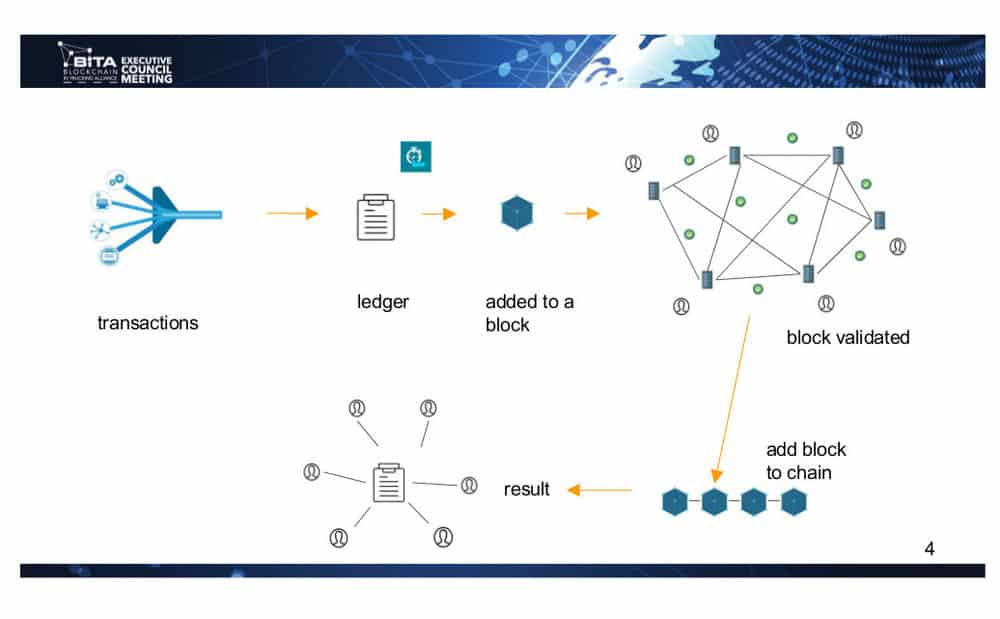
Leading expert walks BiTA members through terminology, benefits of blockchain
When people discuss blockchain, often the concept is too abstract to grasp. In many respects, you need a phD to understand it. So it was fortuitous for Blockchain in Transport Alliance (BiTA) members that the group’s first meeting in Atlanta recently had just such a person.
Rajat Rajbhandari, a research engineer at Texas A&N’s Transportation Institute, holds a phD. He is also co-founder of TruckIN Europe, a Berlin based tech startup developing asset sharing platform for transportation, and co-founder of Blocksec, a blockchain development firm. Rajbhandari took the audience members of nearly 150 through a lesson in Blockchain 201 – explaining in some detail how a blockchain works and some of its components.
Simplified, Rajbhandari began, a blockchain is a ledger of transactions that are stored in data blocks linked in a chain. Those blocks are distributed and shared within a network and validated by the network using a common protocol.
Within a blockchain, though, four key elements are needed, he said. They are a ledger, consensus, cryptography and business logic. The ledger is simply the chronological transactions in chained blocks or nodes. The nodes include “hashes” which are the equivalent of a “fingerprint of the transaction,” Rajbhandari explained.
“If you change anything in the transaction, the hash changes,” he noted. This allows participants to see the transactions, see each different transaction, and validate the transactions.
The nodes would include a merkle root, which is similar to a tree. According to Investopedia, a merkle root or merkle tree is a “block of transactions [that are] run through an algorithm to generate a hash, which is a string of numbers and letters that can be used to verify that a given set of data is the same as the original set of transactions, but not to obtain the original set of transactions.” In cryptography and computer science, a merkle tree is a tree in which every leaf node is labelled with a data block and every non-leaf node is labelled with the cryptographic hash of the labels of its child nodes. Hash trees allow efficient and secure verification of the contents of large data structures.
A node would also include a time stamp, the previous block hash id, the current block hash id, and the next block hash id, along with the value of the block, if there is one.
The consensus is important as this is the common protocol for validating transactions and blocks. The consensus would follow certain generally accepted standards, such as those that BiTA is working to develop, as well as standards agreed upon between parties. The consensus means the nodes in a network agree on the same data. In an enterprise blockchain, this would be the validators. In Bitcoin blockchain, it is the miners.

Cryptography, not to be confused with cryptocurrencies, is what verifies the origin of the transaction either through a digital signature or a public or private key that gives the user access to the blockchain. Once verified, it creates immutable blocks (hashes) that are similar to a fingerprint for each transaction.
Business logics are actually what makes the blockchain work. They manage the interaction, visibility and can integrate with smart contracts. “Essentially, it [gives] permission to read and write transactions …and how smart contracts will be integrated with your business workflow,” Rajbhandari said.
Smart contracts are among the first areas where the supply chain may benefit from blockchain. These are not a piece of code, Rajbhandari stressed, but rather a contract that resides in a blockchain and inherits features of the blockchain. They provide conditions that generate a value transfer – be it monetary or assets – involving humans-to-humans, humans-to-machines, or machines-to-machines.
For example, the smart contract could trigger a payment if certain conditions within the blockchain transaction are met.
Rajbhandari says the goal of blockchain should be to “outsource trust to a network.”
One of the benefits of blockchain is that firms on different transportation management systems can still communicate in a blockchain.
“Blockchain is not an end product,” Rajbhandari said. “It’s an idea; it’s a framework; it’s an operational philosophy. If properly implemented, blockchain can be a common language between companies.”
Stay up-to-date with the latest commentary and insights on FreightTech and the impact to the markets by subscribing.










